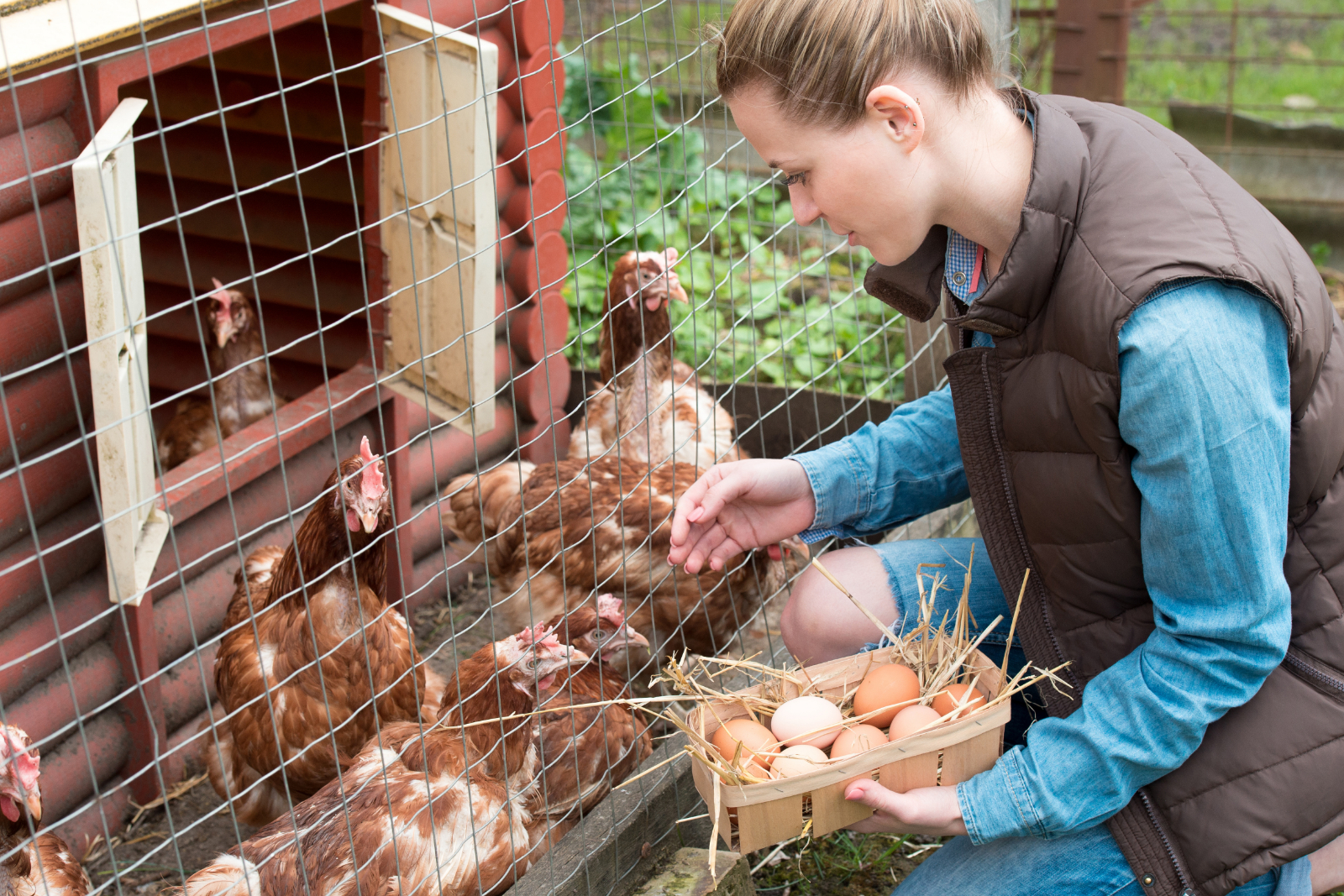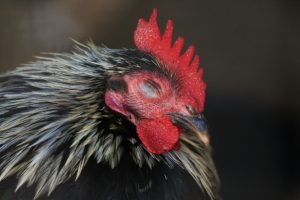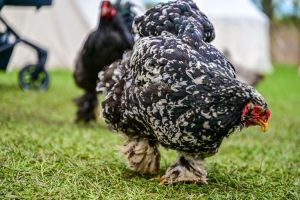Nothing beats collecting fresh eggs from your own backyard flock. With proper care and attention, backyard chickens can provide a steady supply of nutritious eggs throughout most of the year. This guide covers everything needed to maximize egg production while keeping your hens healthy and happy.
Creating the Right Environment for Laying
Chickens need specific conditions to lay eggs consistently. Here’s what makes the difference between occasional and regular laying:
Proper Housing
A comfortable coop provides the security and shelter hens need to lay regularly. The coop should include:
- Clean, private nesting boxes (one box per 4-5 hens)
- At least 4 square feet (0.37 square meters) of coop space per bird
- Proper ventilation without drafts
- Protection from predators and harsh weather
The nesting boxes should be slightly elevated and filled with clean straw or wood shavings. Place them in a darker, quiet area of the coop where hens can lay undisturbed.
Fresh Water – An Absolute Necessity
Access to clean, fresh water is crucial for egg production. Chickens will stop laying if they run out of water, and may even start eating their own eggs to obtain moisture. Place multiple water sources around the coop and run, clean them regularly, and check water availability at least twice daily. During winter, take extra precautions to prevent water from freezing.
Light Requirements
Daylight plays an important role in egg production. Hens need about 14-16 hours of light daily to maintain consistent laying. During shorter winter days, some chicken keepers add supplemental lighting to the coop using a timer. If using artificial light, implement it gradually and maintain a consistent schedule.
Nutrition for Egg Production
Proper nutrition directly affects laying ability. Hens need:
- High-quality layer feed (16-18% protein) as the main diet
- Fresh, clean water available at all times
- Calcium supplements like oyster shell offered separately
- Limited treats (no more than 10% of total diet)
While kitchen scraps can supplement their diet, the majority should either come from complete layer feed – or from free ranging in an area that is rich in nutrients, and that allows the hens to choose their own diet.
Collecting and Storing Eggs
Collect eggs at least once daily and handle eggs with care to prevent cracks. Collecting eggs directly in a carton or in an egg-collecting basket like this one can keep your eggs safe between nesting box and storage.
Avoid washing eggs before storage to keep them lasting longer. Every egg has a natural protective coating that seals the shell’s pores, preventing bacteria from entering while allowing the egg to breathe. Washing removes this protective layer, making eggs more susceptible to contamination and reducing their shelf life. Instead of washing, brush off dirt using a clean, dry cloth or soft brush. Save the washing for just before you’re ready to use the eggs.
Always store eggs with the pointy end down, and keep them at a consistent cool temperature.
Don’t store eggs near strong-smelling foods.
When Do Chickens Start Laying?
Young pullets typically begin laying their first eggs at the age of 3-6 months old, though this can vary by breed and season. The first few eggs might be smaller than normal or have odd shapes – this is completely natural as the hen’s reproductive system matures. If your pullets start laying in fall or winter, you might need to wait until spring to see consistent laying patterns develop.
While most chickens start laying between 18-22 weeks of age, the timing can vary significantly by breed. Some breeds mature quickly and start laying early, while others take their time to develop.
- Leghorns, Golden Comets, and Red Sex Links are early layers, as they start laying around 16-18 weeks
- Rhode Island Reds, Plymouth Rocks, Australorps and Wyandotte are average and start at 20-24 weeks
- Late maturing breeds include Orpingtons, Silkies, and Cochins who may take 25-30 weeks to start laying their first eggs
Keep in mind that these are general guidelines – individual birds may start earlier or later. The first few eggs might be smaller than normal or have odd shapes – this is completely natural as the hen’s reproductive system matures. If your pullets start laying in fall or winter, you might need to wait until spring to see consistent laying patterns develop.
Expected Egg Production for Different Breeds
Most hens lay one egg every 24-26 hours, taking occasional days off. You can expect 200-300 eggs annually per hen during their prime laying years. Production naturally peaks in spring and summer, with a gradual decrease during shorter days.
Different chicken breeds have varying laying capabilities. Here’s what you can expect:
Heavy producers (280-320 eggs annually)
- Leghorns – Known for their prolific white egg laying, averaging 280-320 eggs per year
- Rhode Island Reds – Dependable layers producing 250-300 brown eggs annually
- Plymouth Rocks – Consistent layers providing 240-280 brown eggs yearly
Medium producers (200-250 eggs annually)
- Buff Orpingtons – Steady layers producing 200-240 brown eggs per year
- Wyandottes – Reliable layers offering 200-240 brown eggs annually
- Sussex – Consistent producers laying 220-250 light brown eggs yearly
Light producers (150-180 eggs annually)
- Silkies – Laying about 150 cream-colored eggs per year
- Polish – Producing roughly 150-180 white eggs annually
- Cochins – Offering around 160 brown eggs per year
Age-Related Changes in Laying
Egg production naturally changes as hens age. During their first year of laying, hens are at their most productive. You’ll typically see peak production during the first two years, after which laying gradually decreases. Expect about a 10-20% reduction in egg production each year after the second year.
This decline is completely natural and varies by breed and individual hen. Some hens might continue laying consistently for several years, while others may show more significant decreases. Many chicken keepers choose to keep their older hens even as egg production declines, as these experienced birds often contribute to flock stability and remain valuable members of the backyard flock.
Troubleshooting Laying Issues
When egg production drops, several factors might be responsible. Here’s how to identify and address common problems:
Nutrition-Related Issues
Poor nutrition often leads to decreased egg production. If your hens suddenly lay fewer eggs, first check their feed and water situation. Ensure they’re receiving high-quality layer feed with adequate protein levels (16-18%). Watch for signs of calcium deficiency, such as soft-shelled or unusually small eggs.
To address nutritional concerns, verify that feeders remain full and clean, and that all hens have easy access. If you suspect calcium defficiency, offer calcium supplements (or dried and crushed egg shells) separately from their main feed, allowing hens to self-regulate their calcium intake. If you’ve recently changed feed brands or types, this might explain the production drop – try returning to the previous feed or transition more gradually.
Environmental Challenges
Temperature and coop environment can significantly impact laying patterns. Poor ventilation or uncomfortable temperatures can cause stress and reduce egg production. During summer, temperatures above 90°F (32°C) can cause a drop in egg production, while winter brings its own challenges with shorter days and cold stress.
For optimal laying conditions, ensure proper ventilation while preventing drafts. Add extra bedding during cold months and provide shade or cooling options during hot weather. Check that nesting boxes remain clean and easily accessible. Sometimes simply moving nesting boxes to a quieter location or adding visual barriers between boxes can encourage regular laying.
Health and Stress Factors
Health issues often manifest first as decreased egg production. Watch for signs of illness such as reduced appetite, lethargy, or unusual droppings. External parasites like mites can cause significant stress, while internal parasites may not show obvious symptoms but still affect laying.
Regular health checks help catch problems early. Implement a consistent cleaning schedule, provide dust bathing areas, and monitor for signs of parasites or illness. Minimize stress by maintaining a consistent routine and protecting your flock from predator threats. If multiple hens show symptoms or egg production drops suddenly across the flock, consult with a veterinarian.
Seasonal Changes and Molting
Seasonal changes naturally affect egg production.
- Most hens lay fewer eggs during winter months when daylight hours decrease.
- The annual molting period, typically occurring in fall, temporarily pauses egg laying as hens direct energy toward growing new feathers.
To manage seasonal changes, you could consider adding supplemental light during winter months to maintain more consistent laying.
During molting, support your hens with slightly increased protein in their diet to help them through the feather-growing process.
These natural breaks in laying help hens rest and recover, which contributes to their long-term health and productivity.
Monitoring Egg Production
To maintain consistent egg production:
- Keep detailed records of laying patterns
- Keep track of feed consumption
- Watch for early signs of problems
- Implement seasonal adjustments proactively
- Build relationships with local chicken keepers and veterinarians
With proper care and attention to these guidelines, backyard hens can provide a reliable source of fresh eggs throughout most of the year. Remember that some variation in laying is natural and expected – focus on maintaining healthy, happy hens and the eggs will follow.





0 Comments